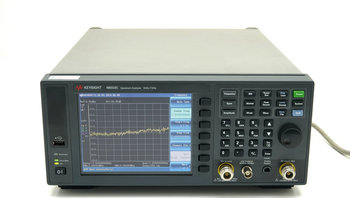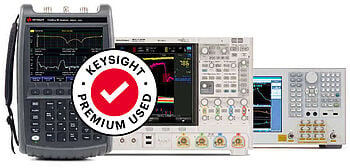- Introduction
- Understanding Resolution Bandwidth (RBW)
- How RBW Works
- Why Does RBW Matter?
- Key Applications of RBW in Signal Analysis
- Distinguishing Overlapping Signals
- Noise Analysis
- Spectrum Management and Regulatory Compliance
- How RBW Works in Spectrum Analyzers
- Advantages of Narrow RBW
- Drawbacks of Narrow RBW
- When to Use Wide RBW
- Comparing RBW with VBW
- Practical Considerations in Spectrum Analysis
- How to Select the Right RBW:
- Conclusion
- Whenever You’re Ready, Here Are 5 Ways We Can Help You
Have you ever wondered how a spectrum analyzer can distinguish between two signals that are very close in frequency?
This ability stems from Resolution Bandwidth (RBW), a key parameter that allows it to differentiate between signals that are adjacent to each other on the frequency spectrum.
When performing signal analysis, understanding RBW is critical for fine-tuning measurements to achieve high precision.
| Key Takeaway |
|---|
| The circular economy transforms the way we produce and consume by keeping materials in use for as long as possible through reduction, reuse, and recycling. This approach not only minimizes waste and resource consumption but also fosters sustainable economic growth and environmental resilience. |
Understanding Resolution Bandwidth (RBW)
Resolution Bandwidth (RBW) refers to the bandwidth of the intermediate frequency (IF) filter in a spectrum analyzer.
This filter determines the range of frequencies that pass through the analyzer at any given point. Essentially, RBW dictates the smallest frequency difference between two signals that the analyzer can resolve.
To break it down:
- A narrow RBW allows for better separation of closely spaced signals by making the filter more selective.
- A wide RBW, on the other hand, lets more frequency content pass through but at the cost of finer frequency resolution.
Imagine you're looking at two peaks on a spectrum plot that represent two signals. If the RBW is too wide, these two peaks may merge into one, making it impossible to tell them apart. A narrower RBW would show them as distinct, separate signals.
How RBW Works
RBW is directly linked to the ability of your test equipment, like a spectrum analyzer, to accurately display frequency information.
The narrower the RBW, the higher the instrument’s frequency resolution, allowing it to reveal minute differences between signals.
Generally, narrower RBW settings lower noise floor. However, narrower RBW settings may also reduce the signal’s strength because the analyzer filters out more of the signal, increasing the noise in the measurement.
Why Does RBW Matter?
The RBW setting is critical in several applications where frequency selectivity is key. Some common situations where RBW plays a crucial role include:
- Communication systems: When analyzing different frequency bands in telecommunications, resolving two closely spaced channels requires narrow RBW settings.
- Signal identification: When signals are closely spaced in frequency, resolving individual components requires precise tuning of RBW.
- Interference detection: RBW helps in identifying the presence of interfering signals that could otherwise blend into the noise.
In these cases, selecting an appropriate RBW ensures the spectrum analyzer can differentiate between signal components and give accurate readings.

Key Applications of RBW in Signal Analysis
Fine-tuning RBW ensures you get precise measurements, whether you're resolving closely spaced signals, analyzing weak signals in noisy environments, or ensuring compliance with frequency regulations.
Adjusting RBW helps you adapt to different scenarios in industries such as telecommunications, aerospace, and broadcasting, where frequency precision and noise control are critical for system performance.
Distinguishing Overlapping Signals
In real-world applications like telecommunications or radar systems, signals often appear close together on the frequency spectrum.
For example, in mobile communication networks, various carriers transmit at different, but often closely spaced, frequencies.
To avoid interference and ensure clear communication, engineers need to precisely isolate these frequencies. A narrow RBW is essential in these situations.
For example, let’s say you are working in an RF environment where two signals, one at 850 MHz and another at 851 MHz, need to be analyzed.
A wide RBW of 1 MHz may blur these two signals into one broad peak. By narrowing the RBW to 10 kHz, your spectrum analyzer will be able to display these signals as two distinct peaks.
Noise Analysis
When measuring weak signals, noise can often drown out the useful data.
A narrow RBW improves signal-to-noise ratio (SNR) by filtering out unnecessary frequency content. This makes it easier to spot the actual signal you’re interested in, even when it is buried under a significant amount of noise.
Engineers in fields such as aerospace or defense, where weak signals are common, often rely on smaller RBW settings to detect and measure these signals accurately.
Spectrum Management and Regulatory Compliance
In industries such as telecommunications or broadcasting, adhering to strict frequency allocation guidelines is crucial. Overlapping frequencies can cause interference that degrades system performance.
By using narrow RBW settings during spectrum analysis, you can ensure that devices are operating within their allocated bands, thus avoiding costly regulatory violations.
How RBW Works in Spectrum Analyzers
When using a spectrum analyzer, RBW is one of the most important settings for precise measurements. Spectrum analyzers display signal power as a function of frequency.
Adjusting RBW influences both the appearance of signals and the quality of the measurements you take. Here's how:
| Parameter | Narrow RBW | Wide RBW |
| Frequency Resolution | High (better for distinguishing signals) | Low (signals may blur together) |
| Sweep Time | Longer (takes more time per sweep) | Shorter (faster measurements) |
| Signal-to-Noise Ratio (SNR) | Lower (due to filtering of signal) | Higher (but less selective) |
| Common Use Cases | Identifying closely spaced signals, measuring weak signals | Broad-spectrum measurements, faster analysis |
Advantages of Narrow RBW
A narrow RBW is ideal when precision is your main objective.
The filter becomes more selective, and this higher selectivity means that signals close in frequency can be separated from one another.
Here are some cases where a narrow RBW excels:
- Weak signal detection: In noisy environments, a narrow RBW allows you to see signals that might otherwise be hidden.
- High-precision applications: For tasks such as signal demodulation or when examining subtle frequency shifts in radar systems, a narrow RBW provides the accuracy required.
Drawbacks of Narrow RBW
A narrow RBW comes with its trade-offs.
Because the analyzer is focusing on a smaller portion of the spectrum at once, it will take longer to scan the entire range of frequencies.
This can be problematic when you're working under time constraints or when you need to perform quick, broad measurements.
When to Use Wide RBW
On the flip side, a wide RBW is beneficial when you need to perform quick, broad-spectrum measurements.
In cases where precision is less important than speed, a wide RBW is the better choice. Applications include:
- Fast signal monitoring: When you're scanning a broad range of frequencies quickly to check for major anomalies.
- Rough diagnostics: Wide RBW helps when you’re just looking for a general overview of signal strength across a spectrum.
Comparing RBW with VBW
While Resolution Bandwidth (RBW) focuses on frequency resolution, Video Bandwidth (VBW) deals with how the signal appears on the screen.
VBW helps smooth out noise, improving the visibility of the signal.
Here's a comparison of the two:
| Aspect | RBW | VBW |
| Purpose | Determines frequency resolution | Smooths out noise for clearer display |
| Signal Analysis | Resolves closely spaced signals | Reduces noise for visual clarity |
| Adjustment Impact | Impacts frequency resolution and measurement speed | Affects display smoothness, not signal fidelity |
| Trade-offs | Narrow RBW increases noise but improves signal separation | Larger VBW reduces noise but can obscure narrow signals |
Practical Considerations in Spectrum Analysis
Modern spectrum analyzers and oscilloscopes, such as those from Keysight offer advanced RBW settings that allow for precise control over how signals are captured and displayed.
By tuning RBW to fit the signal environment, engineers can optimize their analyses. However, proper RBW selection also depends on the specific goals of your measurement, such as whether you prioritize speed, resolution, or noise reduction.
How to Select the Right RBW:
- Identify your goal: Are you measuring a broad spectrum or zooming in on a specific signal? Use wide RBW for the former and narrow RBW for the latter.
- Consider signal spacing: For closely spaced signals, select a narrow RBW to accurately resolve each component.
- Balance sweep time and resolution: Narrower RBW increases measurement time. Choose the right balance based on your project timeline.
Conclusion
Whether you need to distinguish between closely spaced signals or scan broad frequency ranges efficiently, the correct RBW setting ensures your measurements align with your project goals.
Adjusting RBW appropriately helps balance resolution, noise, and speed, making it a vital parameter for engineers working in telecommunications, RF testing, and beyond.
For professionals looking to upgrade or expand their testing capabilities, Keysight's Used Equipment Store offers premium tools like oscilloscopes, spectrum analyzers, function generators, and multimeters.
These certified pre-owned instruments provide high performance at reduced costs, allowing engineers to access reliable equipment without long lead times. Explore this resource to find solutions that fit both your technical needs and budget.

Whenever You’re Ready, Here Are 5 Ways We Can Help You
- Browse our Premium Used Oscilloscopes.
- Call tech support US: +1 800 829-4444
Press #, then 2. Hours: 7 am – 5 pm MT, Mon– Fri - Talk to our sales support team by clicking the icon (bottom right corner) on every offer page
- Create an account to get price alerts and access to exclusive waitlists.
- Talk to your account manager about your specific needs.
